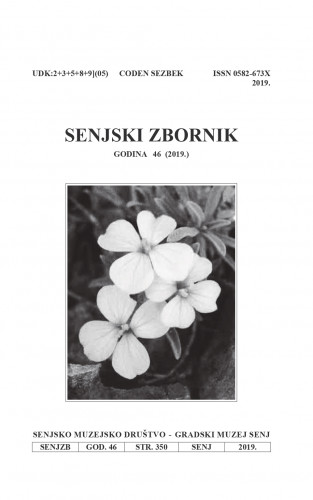This paper presents a part of the results of years of archaeological research, whose main goal is the study of complex process of Romanisation of peregrine civitates in the area of Velebit Mt. during the first century BC and the first century AD. Civitas Lopsica has been selected as an example of Romanisation, whose center was located at the Gradina hillfort, near present day village of Sveti Juraj, located at the foot of Velebit Mountain near Senj. Lopsica is mentioned in ancient historical sources but it is particularly important that it was mentioned in the list of important Liburnian settlements by Plinius the Elder who referred to it as oppidum. During the first century AD, Lopsica achieved municipal status, which was confirmed by epigraphic evidence. Onomastic analysis shows that the inscriptions mentioned members of the autochthonous Romanised aristocracy, who maintained their acquired positions of authority and were a privileged class in the administrative and economic structure of the municipium. Civitas and the municipium of Lopsica encompassed the coastal region as well as the area that stretched deep into the interior of Velebit Mountain. Combined with the data from earlier studies, recent reviews of terrain and aerial photos have enabled a better overview of the landscape and thus more precise determination of the community boundaries, as well as the way of life in the mountain area that, considering its high karst morphology, seems highly unsuitable for living. The mountain provided great conditions for cattle breeding and the exploitation of forest resources, from which locals could have had significant benefits. The favorable strategic and transportation position and a busy harbor encouraged the development of trade which took place over the mountain passes with Iapodes inland. Changes that occurred in the landscape during the Iron Age and early antiquity can still be seen today.; U radu se prikazuje dio rezultata višegodišnjeg arheološkog istraživanja, čiji je glavni cilj proučavanje kompleksnog procesa romanizacije peregrinskih civitates na prostoru Velebita tijekom 1. st. prije Krista i u 1. st. nakon Krista. Kao primjer romanizacije odabrana je civitas Lopsica, čije se središte nalazilo na Gradini u današnjem podvelebitskom mjestu. Sveti Juraj kod Senja. Lopsica se spominje u antičkim povijesnim vrelima, osobito je važan njezin spomen kod Plinija Starijeg (Naturalis historia III, 139, 140), gdje je u popisu važnijih liburnskih naselja navedena kao oppidum. Lopsica tijekom 1. st. nakon Krista postiže municipalni status, koji je i epigrafski potvrđen. Onomastička analiza pokazuje da su na natpisima navedeni pripadnici romanizirane autohtone aristokracije, koji u upravnoj i gospodarskoj strukturi municipija zadržavaju stečene pozicije vlasti i čine povlašteni sloj. I civitas i municipium Lopsica imali su svoj teritorij, koji je osim priobalja obuhvaćao i prostor koji se duboko prostirao u unutrašnjost Velebita. Uz podatke iz ranijih istraživanja, korištenje suvremenih metoda prospekcije terena, osobito metoda zračne arheologije, omogućilo je preciznije određenje granica zajednice i uvid u organizaciju života na planinskom prostoru koji se, gledajući njegovu izrazito krašku morfologiju, čini krajnje neprikladnim za život. Planina je pružala vrlo dobre uvjete za bavljenje stočarstvom, ali i za eksploataciju šumskih resursa, od čega je lokalno stanovništvo moglo imati značajnu korist. Povoljan strateški i prometni položaj te dobra luka poticali su razvoj trgovine, koja se preko planinskih prijevoja odvijala s japodskom unutrašnjošću. Promjene koje su tijekom željeznog doba i početkom antike nastale u krajoliku, mogu se i danas uočiti.
Sažetak

 Senjski zbornik : prilozi za geografiju, etnologiju, gospodarstvo, povijest i kulturu : 46(2019).
Senjski zbornik : prilozi za geografiju, etnologiju, gospodarstvo, povijest i kulturu : 46(2019).